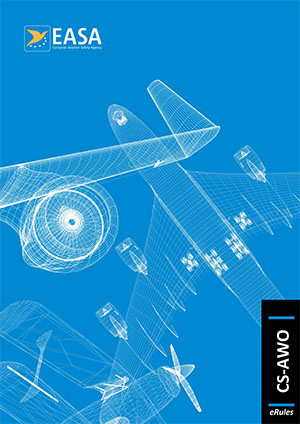CS AWO.A.HUD.101 Applicability and terminology
ED Decision 2022/007/R
(a) A head-up display (HUD) is a display system that presents flight information into the pilot’s forward external field of view.
(b) A head-up display (HUD) guidance landing system (HUDLS) is a total airborne system which generates and shows head-up guidance to the pilot during the approach and landing (and roll‑out, if applicable) or a go-around. It includes all the sensors, computers, power supplies, indications and controls.
(c) A display will be considered to be equivalent to a HUD provided it can be shown to comply with the following:
(1) The display shall be presented head-up and shall not require transition of visual attention to the head-down display (HDD) in order to view the displayed primary flight information.
(2) The display shall be conformal with the pilot’s external view.
(3) The display shall enable simultaneous viewing of aircraft flight symbology, imagery (if applicable) and the external view.
(4) The display shall have characteristics and dynamics that are suitable for the manual control of the aircraft.
(5) The display of imagery, information and symbology shall be clearly visible to the pilot flying in their normal position with the line of vision looking forward along the flight path.
[Issue: CS-AWO/2]
AMC AWO.A.HUD.101 Applicability and terminology
ED Decision 2022/007/R
A head-up display (HUD), or equivalent display, should comply with the relevant requirements of AMC 25-11.
[Issue: CS-AWO/2]
ED Decision 2022/007/R
If a HUD (or equivalent display) is used for approach guidance, it shall provide sufficient information to permit the pilot to initiate and stabilise a go-around manoeuvre at any point during the approach and the flare without reverting to other displays. This information shall not lead to a speed incompatible with normal go-around procedures and speeds. The approach information shall be removed on selection of go-around unless it is shown that its presence does not interfere with the go‑around information. The go-around information shall not be changed or lost if the aeroplane touches the ground during a go-around. In the event of a HUD (or equivalent display) failure at any time during the go-around, the pilot shall be able to revert to HDDs to complete the go-around manoeuvre safely without loss of performance.
[Issue: CS-AWO/2]
CS AWO.A.HUD.103 HUD (or equivalent display) information below decision height
ED Decision 2022/007/R
(See AMC AWO.A.HUD.103)
Information presented on the HUD (or equivalent display) below the decision height (DH) shall not mislead or distract the pilot, and shall not jeopardise the safety of the landing.
[Issue: CS-AWO/2]
AMC AWO.A.HUD.103 HUD information
ED Decision 2022/007/R
It is acceptable to remove information from the HUD, provided that doing so does not cause a distraction to the pilot.
A head-up guidance landing system (HUDLS) is typically used for primary approach guidance for decision heights (DHs) down to 15 m (50 ft).
A HUDLS can be used during the following flight phases to either control the aircraft or monitor the autopilot:
(1) take-off (if applicable);
(2) approach and landing (and roll-out, if applicable); or
(3) go-around.
[Issue: CS-AWO/2]
CS AWO.A.HUD.104 Control of take-off roll, flight path and ground roll
ED Decision 2022/007/R
(a) Head-up display landing system (HUDLS)
The system shall provide sufficient guidance information to enable a pilot that is competent to conduct the intended operation to intercept the xLS approach path, if that capability is provided, to track it, to land the aeroplane within the prescribed limits or to perform a go-around without reference to other cockpit displays. It shall not require exceptional piloting skill to achieve the required performance. (See CS AWO.B.SACATI.113 or CS AWO.B.CATII.113 or CS AWO.B.CATIII.115(a) and (b) or CS AWO.B.CATIII.117)
(b) The transition from approach/flare guidance to roll-out control guidance shall be smooth and shall not distract the pilot from performing the intended operation.
(c) If the autopilot is used to control the flight path of the aeroplane to intercept and establish the xLS approach path, the point during the approach at which the transition from automatic to manual flight takes place shall be identified and taken into account in the performance demonstration (see CS AWO.B.CATIII.115). The transition from autopilot to head-up guidance shall not require exceptional piloting skill, alertness, strength or excessive workload.
(d) For take-off roll, the HUD (or equivalent display) shall meet the performance requirements of CS AWO.C.TOO.106.
(e) The HUD characteristics and dynamics shall be suitable for the manual control of the aircraft.
[Issue: CS-AWO/2]
